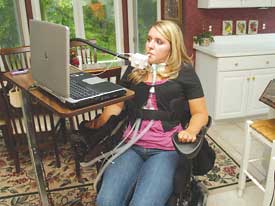As a bright, young cheerleader trying out for the high school varsity squad, 14-year-old Laura Jackson had everything going for her.

But when a back flip went wrong during a try-out without a trained spotter on hand, Laura landed on her head fracturing her neck and damaging her spinal cord. Laura is now paralyzed and breathes with the help of a ventilator.
Cheerleading has become the leading cause of catastrophic injury in young female athletes, says Amy Miller Bohn, a physician at the U-M Health System‘s Department of Family Medicine.
Data from the Consumer Product Safety Commission shows that rates of injuries from cheerleading accidents have gone from nearly 5,000 in 1980 to close to 26,000 to 28,000 in the past few years, Miller Bohn says.
In addition, the leading cause of catastrophic injuries in female athletes is cheerleading, according to The National Center for Catastrophic Sports Injury Research. They account for approximately 65 to 66 percent of all female catastrophic injuries in either high school or college.
“If you look at cheerleading injuries, most of them are still more the common types of things that we should think about — muscle strains or pulls, ligament injuries, tendon injuries,” Miller Bohn says. “The concern is that there are certainly a fair number of increasingly severe injuries.”
Because of the increase in degree of difficulty in cheerleading skills, increased acrobatics and stunt activities may be increasing the risk of severity of injury.
Catastrophic injuries seen in cheerleading involve either death, injuries that results in disability that are often related to head trauma or spine trauma. Doctors also are seeing more injuries that a person may not be able to recover from completely — such as concussions or severe fractures.
Cheerleading injuries appear to be on the rise partly because of an increase in participants, but the sport also has changed significantly in the last 25 years. Cheerleading no longer consists of athletes standing on the sidelines, rooting for a team.
What can parents and school officials do to help prevent injuries?
An area to focus in is coaching staff. It’s recommended that a coach have experience in first aid and CPR training. Good training in how to coach athletes’ development, strength, conditioning and flexibility is ideal.
Another area of concern is equipment. A spring-loaded floor is a good idea to prevent injuries and to cushion a fall. Mats also are important.
Parents whose children are interested in cheerleading should ask questions about the coach’s experience, what type of athletes the coach has worked with and if they have experience with gymnastics stunt work. They also need to know what the plan is for that cheerleading squad, what types of activities they will perform, who is supervising and where activities will be performed.

